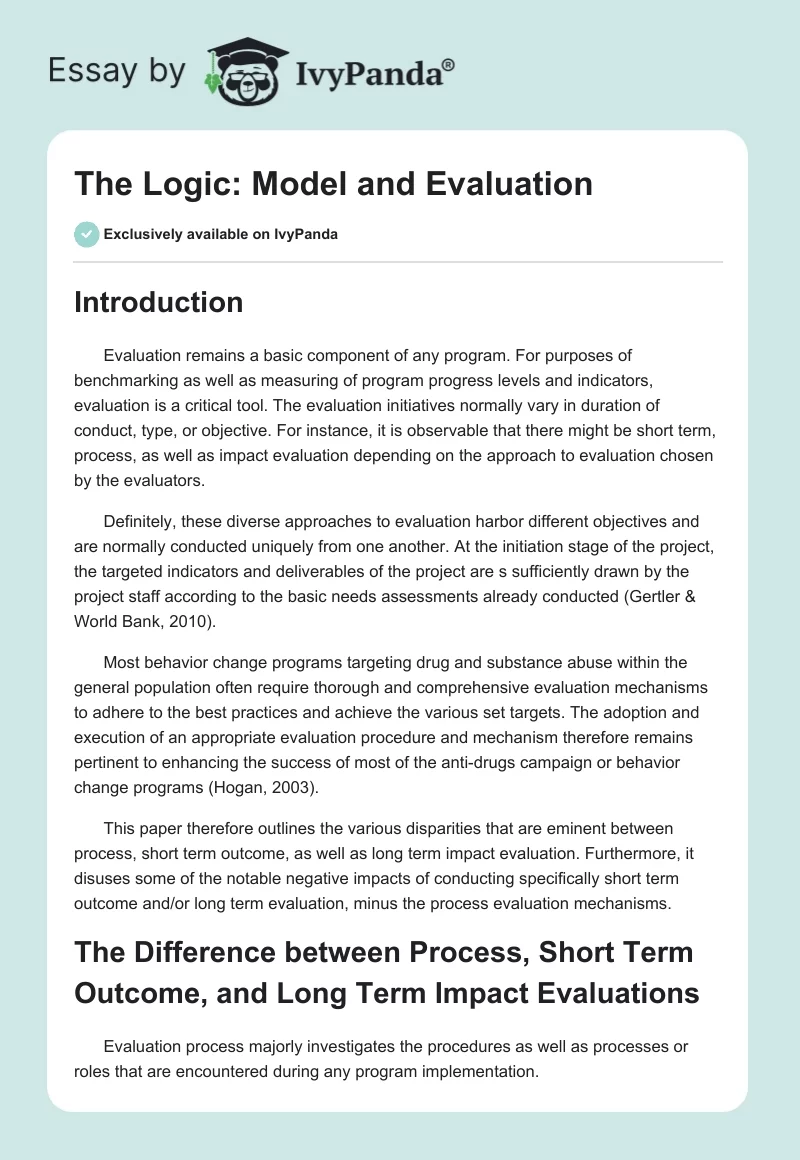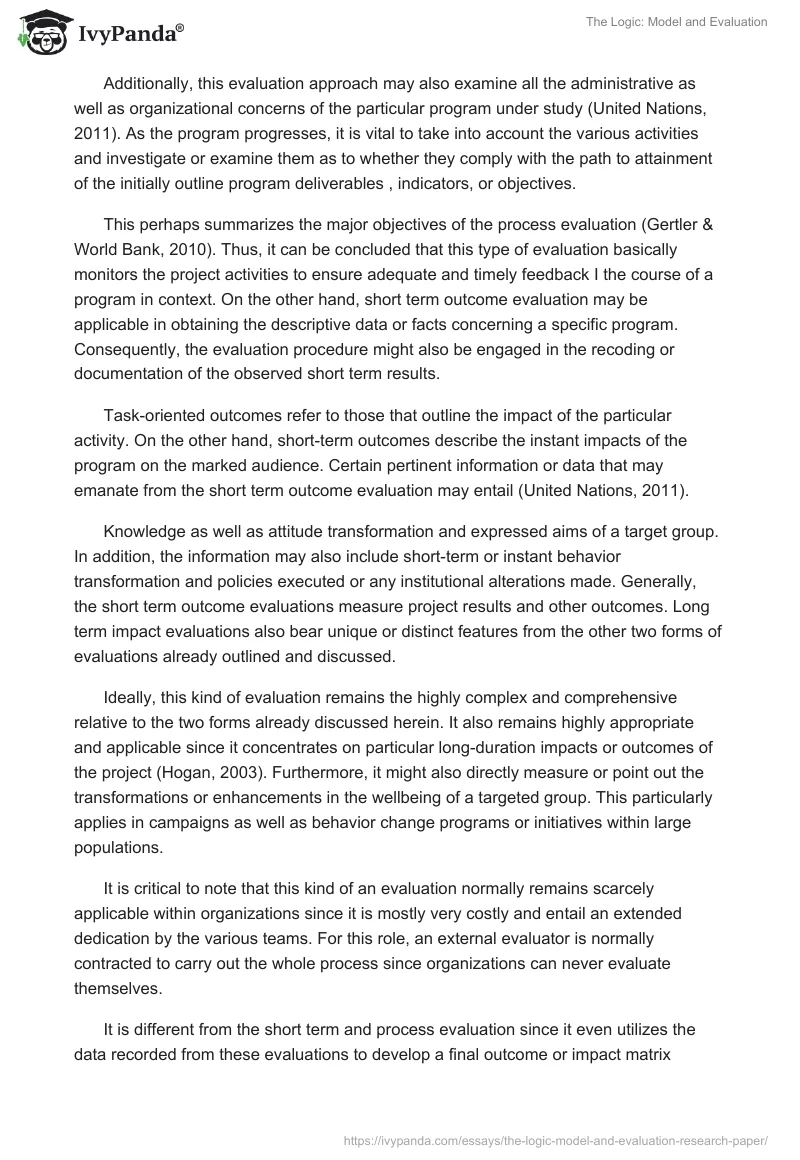Introduction
Evaluation remains a basic component of any program. For purposes of benchmarking as well as measuring of program progress levels and indicators, evaluation is a critical tool. The evaluation initiatives normally vary in duration of conduct, type, or objective. For instance, it is observable that there might be short term, process, as well as impact evaluation depending on the approach to evaluation chosen by the evaluators.
Definitely, these diverse approaches to evaluation harbor different objectives and are normally conducted uniquely from one another. At the initiation stage of the project, the targeted indicators and deliverables of the project are s sufficiently drawn by the project staff according to the basic needs assessments already conducted (Gertler & World Bank, 2010).
Most behavior change programs targeting drug and substance abuse within the general population often require thorough and comprehensive evaluation mechanisms to adhere to the best practices and achieve the various set targets. The adoption and execution of an appropriate evaluation procedure and mechanism therefore remains pertinent to enhancing the success of most of the anti-drugs campaign or behavior change programs (Hogan, 2003).
This paper therefore outlines the various disparities that are eminent between process, short term outcome, as well as long term impact evaluation. Furthermore, it disuses some of the notable negative impacts of conducting specifically short term outcome and/or long term evaluation, minus the process evaluation mechanisms.
The Difference between Process, Short Term Outcome, and Long Term Impact Evaluations
Evaluation process majorly investigates the procedures as well as processes or roles that are encountered during any program implementation.
Additionally, this evaluation approach may also examine all the administrative as well as organizational concerns of the particular program under study (United Nations, 2011). As the program progresses, it is vital to take into account the various activities and investigate or examine them as to whether they comply with the path to attainment of the initially outline program deliverables , indicators, or objectives.
This perhaps summarizes the major objectives of the process evaluation (Gertler & World Bank, 2010). Thus, it can be concluded that this type of evaluation basically monitors the project activities to ensure adequate and timely feedback I the course of a program in context. On the other hand, short term outcome evaluation may be applicable in obtaining the descriptive data or facts concerning a specific program. Consequently, the evaluation procedure might also be engaged in the recoding or documentation of the observed short term results.
Task-oriented outcomes refer to those that outline the impact of the particular activity. On the other hand, short-term outcomes describe the instant impacts of the program on the marked audience. Certain pertinent information or data that may emanate from the short term outcome evaluation may entail (United Nations, 2011).
Knowledge as well as attitude transformation and expressed aims of a target group. In addition, the information may also include short-term or instant behavior transformation and policies executed or any institutional alterations made. Generally, the short term outcome evaluations measure project results and other outcomes. Long term impact evaluations also bear unique or distinct features from the other two forms of evaluations already outlined and discussed.
Ideally, this kind of evaluation remains the highly complex and comprehensive relative to the two forms already discussed herein. It also remains highly appropriate and applicable since it concentrates on particular long-duration impacts or outcomes of the project (Hogan, 2003). Furthermore, it might also directly measure or point out the transformations or enhancements in the wellbeing of a targeted group. This particularly applies in campaigns as well as behavior change programs or initiatives within large populations.
It is critical to note that this kind of an evaluation normally remains scarcely applicable within organizations since it is mostly very costly and entail an extended dedication by the various teams. For this role, an external evaluator is normally contracted to carry out the whole process since organizations can never evaluate themselves.
It is different from the short term and process evaluation since it even utilizes the data recorded from these evaluations to develop a final outcome or impact matrix (Gertler & World Bank, 2010). However, it is clear that the outcomes usually may not be expressly linked to the impacts of the activity or project.
This is basically due to the manipulations of other outdoor elements on the specific population. Observably, these influences are always noted to be transpiring over longer durations or periods. Some pertinent information that is likely to be drawn from this kind of evaluation may include alterations in morbidity or mortality and transformations in absenteeism from school or work places.
The Danger of Conducting Only Short Term Outcome And /Or Long Term Impact Evaluation, Without Process Evaluation Components
As indicated before, process evaluation is vital since it deals with the active monitoring of the activities as well as inputs involved towards the achievement of both long-term and short term goals. The basic aim behind process evaluation is therefore to put the project processes under a streamlined and uniformly objective system of action.
Therefore, process evaluation remains a critical monitoring approach that unlike both other types of evaluation occurs immediately after a project has been executed. The process occurs throughout the project phase and is basically the directing evaluative component of the program with a fundamental objective of putting the program into the proper channel (Gertler & World Bank, 2010).
Process evaluation just like monitoring, is not the end relative to other forms of evaluation discussed herein. In perspective, process evaluation offers a monitoring aspect to the whole project and is carried out continuously (United Nations, 2011). The process allows projects to identify and recognize the factors that are not pertinent to the project, or the indicators of the project that may not be performing well.
In the execution of process evaluation, the deviant factors or processes are identified and adjustments are conducted in the process to channel the program towards efficiency and success. The basic objective here is to enhance the effectiveness as well as efficiency of any project.
Thus, it is crucial to note that a project might go astray or lose its course of objective if process evaluation components are not considered (United Nations, 2011). This is because the short term outcome as well as the long term impact evaluations usually occurs after specified intervals while process evaluation is a continuous process right from the program initiation stage.
Conclusion
Conclusively, evaluation remains a critical component of any projects and the personalities concerned have to adequately plan and budget for the appropriate evaluation methodology chosen. Basically, process evaluation enables projects to examine critically the factors or elements that are actually occurring against what was initially outlined or planned (Hogan, 2003).
It enables the projects to execute remedial actions to get activities back on the right channel and be answerable to the targeted outcomes that the project aims to attain. Additionally, the process evaluation helps to recognize how finances ought to be allocated across all project activities and to gather facts that may be applied in the other evaluation procedures.
References
Gertler, P. & World Bank. (2010). Impact evaluation in practice. Washington, D.C: World Bank.
Hogan, J. A. (2003). Substance abuse prevention: The intersection of science and practice. Boston: Allyn and Bacon.
United Nations. (2011). Evaluation: Monitoring, Outcome and Impact. Web.


